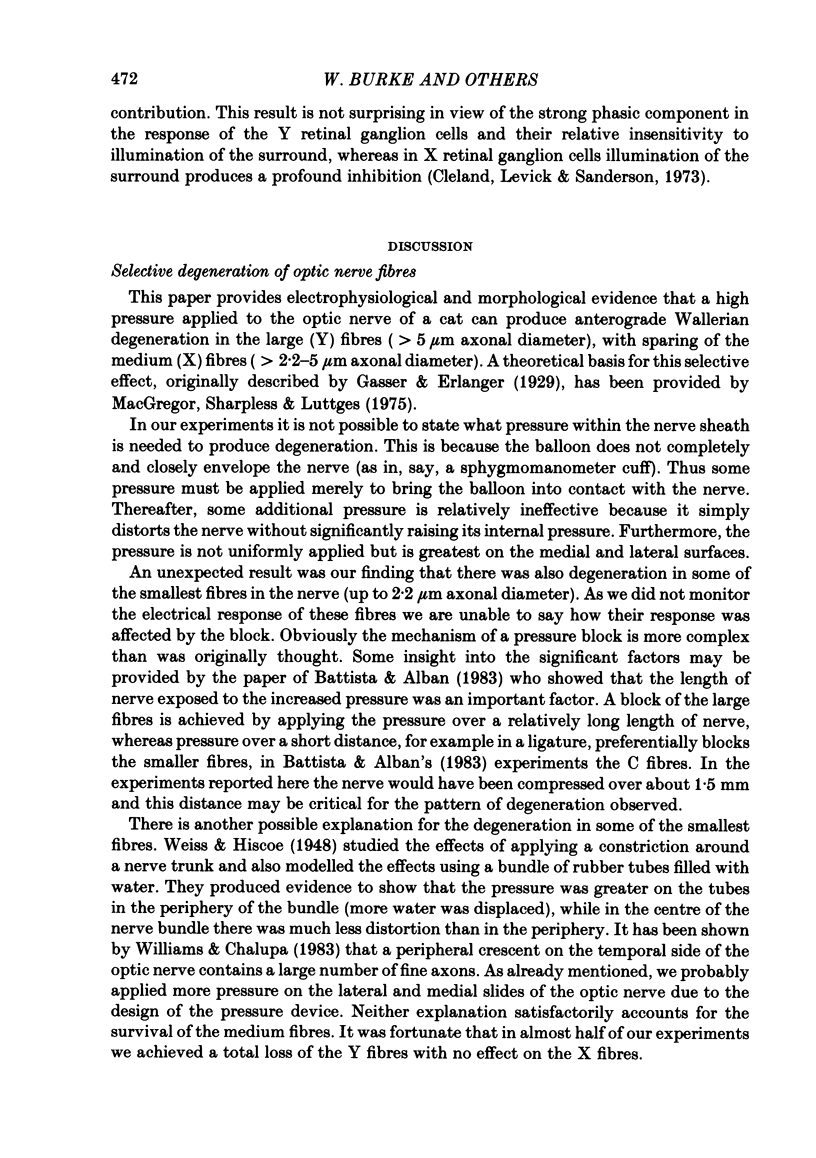Abstract
Using a technique described previously, we have applied pressure to the optic nerve of a cat sufficient to cause conduction block of the t1 response (the response of the Y optic nerve fibres). A greater pressure, usually sufficient to cause a transient block of the t2 response (the response of the X fibres), leads to degeneration of the Y axons caudal to the block. This is demonstrated by the disappearance of the t1 response in this region after 4-5 days and by the presence in electron micrographs of degenerating large (Y) fibres. Some small fibres also show degeneration, but the medium (X) fibres are largely spared. The time course of loss of response in the Y fibres is similar whether the loss is due to a pressure block or to enucleation, suggesting that the pressure block as used by us causes a disruption of the axon. If the pressure is great enough to block part of the t2 response (X fibres) there is also a similarity in time course of loss of response to that following enucleation. Both for the enucleated and the pressure-blocked cat the t2 response fails about 1 day before the t1 response. This is in apparent disagreement with the morphological findings in the literature, confirmed here, indicating an earlier degeneration of the larger fibres. The post-synaptic response in the lateral geniculate nucleus to the t1 input (the r1 response) also fails about 1 day before the t1 response. In the visual cortex the loss of the r1 response reveals more clearly than is normally possible an r2 response, the response of the X optic radiation fibres. The response in the optic nerve or tract to a bright flash of light is dominated by the response of the Y fibres. When these are blocked the response is greatly reduced.
Full text
PDF
















Images in this article
Selected References
These references are in PubMed. This may not be the complete list of references from this article.
- Battista A. F., Alban E. Effect of graded ligature compression on nerve conduction. Exp Neurol. 1983 Apr;80(1):186–194. doi: 10.1016/0014-4886(83)90015-8. [DOI] [PubMed] [Google Scholar]
- Burke W., Burne J. A., Martin P. R. Selective block of Y optic nerve fibres in the cat and the occurrence of inhibition in the lateral geniculate nucleus. J Physiol. 1985 Jul;364:81–92. doi: 10.1113/jphysiol.1985.sp015731. [DOI] [PMC free article] [PubMed] [Google Scholar]
- Cleland B. G., Dubin M. W., Levick W. R. Sustained and transient neurones in the cat's retina and lateral geniculate nucleus. J Physiol. 1971 Sep;217(2):473–496. doi: 10.1113/jphysiol.1971.sp009581. [DOI] [PMC free article] [PubMed] [Google Scholar]
- Cleland B. G., Levick W. R., Sanderson K. J. Properties of sustained and transient ganglion cells in the cat retina. J Physiol. 1973 Feb;228(3):649–680. doi: 10.1113/jphysiol.1973.sp010105. [DOI] [PMC free article] [PubMed] [Google Scholar]
- Clifford-Jones R. E., Landon D. N., McDonald W. I. Remyelination during optic nerve compression. J Neurol Sci. 1980 May;46(2):239–243. doi: 10.1016/0022-510x(80)90082-9. [DOI] [PubMed] [Google Scholar]
- Eysel U. T., Grüsser O. J. Simultaneous recording of pre- and postsynaptic potentials during the degeneration of the optic tract fiber input to the lateral geniculate nucleus of cats. Brain Res. 1974 Dec 13;81(3):552–557. doi: 10.1016/0006-8993(74)90851-8. [DOI] [PubMed] [Google Scholar]
- Fentress J. C., Doty R. W. Effect of tetanization and enucleation upon excitability of visual pathways in squirrel monkeys and cats. Exp Neurol. 1971 Mar;30(3):535–554. doi: 10.1016/0014-4886(71)90153-1. [DOI] [PubMed] [Google Scholar]
- HAYHOW W. R. Experimental degeneration of optic axons in the lateral geniculate body of the cat. Acta Anat (Basel) 1959;37:281–298. doi: 10.1159/000141475. [DOI] [PubMed] [Google Scholar]
- Hinkley R. E., Jr, Green L. S. Effects of halothane and colchicine on microtubules and electrical activity of rabbit vagus nerves. J Neurobiol. 1971;2(2):97–105. doi: 10.1002/neu.480020202. [DOI] [PubMed] [Google Scholar]
- Macgregor R. J., Sharpless S. K., Luttges M. W. A pressure vessel model for nerve compression. J Neurol Sci. 1975 Mar;24(3):299–304. doi: 10.1016/0022-510x(75)90249-x. [DOI] [PubMed] [Google Scholar]
- Malbouisson A. M., Ghabriel M. N., Allt G. Axonal degeneration in large and small nerve fibres. An electron-microscopic and morphometric study. J Neurol Sci. 1985 Mar;67(3):307–318. doi: 10.1016/0022-510x(85)90155-8. [DOI] [PubMed] [Google Scholar]
- REYNOLDS E. S. The use of lead citrate at high pH as an electron-opaque stain in electron microscopy. J Cell Biol. 1963 Apr;17:208–212. doi: 10.1083/jcb.17.1.208. [DOI] [PMC free article] [PubMed] [Google Scholar]
- Saavedra J. P., Vaccarezza O. L., Reader T. A., Pasqualini E. Synaptic transmission in the degenerating lateral geniculate nucleus. An ultrastructural and electrophysiological study. Exp Neurol. 1970 Mar;26(3):607–620. doi: 10.1016/0014-4886(70)90153-6. [DOI] [PubMed] [Google Scholar]
- VAN CREVEL, VERHAART W. J. THE RATE OF SECONDARY DEGENERATION IN THE CENTRAL NERVOUS SYSTEM. I. THE PYRAMIDAL TRACT OF THE CAT. J Anat. 1963 Jul;97:429–449. [PMC free article] [PubMed] [Google Scholar]
- VAN CREVEL, VERHAART W. J. THE RATE OF SECONDARY DEGENERATION IN THE CENTRAL NERVOUS SYSTEM. II. THE OPTIC NERVE OF THE CAT. J Anat. 1963 Jul;97:451–464. [PMC free article] [PubMed] [Google Scholar]
- Williams R. W., Chalupa L. M. An analysis of axon caliber within the optic nerve of the cat: evidence of size groupings and regional organization. J Neurosci. 1983 Aug;3(8):1554–1564. doi: 10.1523/JNEUROSCI.03-08-01554.1983. [DOI] [PMC free article] [PubMed] [Google Scholar]



